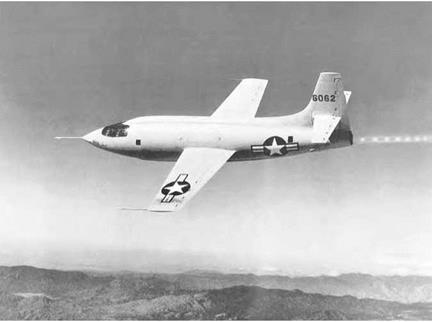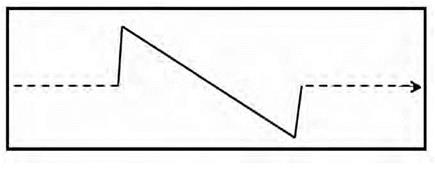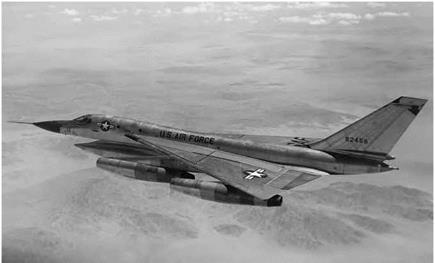From Curiosity to Controversy
In 1947, Muroc Army Airfield, CA, was a small collection of aircraft hangars and other austere buildings adjoining the vast Rogers Dry Lake in the high desert of the Antelope Valley, across the San Gabriel Mountains from the Los Angeles basin. Because of the airfield’s remoteness and clear skies, a small team of Air Force, the NACA, and contractor personnel was using Muroc for a secret project to explore the still unknown territory of supersonic flight. On October 14, more than 40,000 feet over the little desert town of Boron, visible only by its contrail, Capt. Chuck Yeager’s 31-foot-long rocket-propelled Bell XS-1 successfully "broke” the fabled sound barrier.[323] The sonic boom from his little experimental airplane—the first to fly supersonic in level flight—probably did not reach the ground on that historic day.[324] Before long, however, the acoustical signature of the shock waves generated by XS-1s and other supersonic aircraft became a familiar sound at and around the isolated airbase.
In the previous century, an Austrian physicist-philosopher, Ernst Mach, was the first to explain the phenomenon of supersonic shock waves, which he displayed visually in 1887 with a cleverly made photograph showing those formed by a high-velocity projectile, in this case a bullet. The speed of sound, he also determined, varied in relation to the density of the medium though which it passed, such as air molecules. (At sea level, the speed of sound is 760 mph.) In 1929, Jakob Ackeret, a Swiss fluid dynamicist, named this variable "Mach number” in his honor. This guaranteed that Ernst would be remembered by future generations, especially after it became known that the 700 mph speed of Yeager’s XS-1, flying at 43,000 feet, was measured as Mach 1.06.[325]
Humans have long been familiar with and often frightened by natural sonic booms in the form of thunder, i. e., sudden surges of air
|
Bell XS-1 —the first aircraft to exceed Mach 1 in level flight, October 14, 1947. U. S. Air Force. |
pressure caused when strokes of lightning instantaneously heat contiguous columns of air molecules. Perhaps the most awesome of sonic booms—heard only rarely—have been produced by large meteoroid fireballs speeding through the atmosphere. On a much smaller scale, the first acoustical shock waves produced by human invention were the modest cracking noises from the snapping of a whip. The high-power explosives perfected in the latter half of the 19th century were able—as Mach explained—to propel projectiles faster than the speed of sound. Their acoustical shock waves would be among the cacophony of fearsome sounds heard by millions of soldiers during the two World Wars.[326]
On a Friday evening, September 8, 1944, an explosion blew out a large crater in Stavely Road, west of London. The first German V-2 ballistic missile aimed at England had announced its arrival. "After the explosion came a double thunderclap caused by the sonic boom catch-
ing up with the fallen rocket.”[327] For the next 7 months, millions of people would hear these sounds, which would become known as "sonic bangs” in Britain, from more than 3,000 V-2s launched at England as well as liberated portions of France, Belgium, and the Netherlands. Their sound waves would always arrive too late to warn any of those unfortunate enough to be near the missiles’ points of impact.[328] After World War II, these strange noises faded into memory for several years—until the arrival of new jet fighter planes.
In November 1949, the NACA designated its growing detachment at Muroc as the High-Speed Flight Research Station (HSFRS), 1 month before the Air Force renamed the installation Edwards Air Force Base (AFB).[329] By the early 1950s, the desert and mountains around Edwards reverberated with the occasional sonic booms of experimental and prototype aircraft, as did other flight-test locations in the United States and United Kingdom. Scientists and engineers had been familiar with the "axisymmetric” ballistic shock waves of projectiles such as artillery shells (referred to scientifically as bodies of revolution).[330] This was one reason the fuselage of the XS-1 was shaped like a 50-caliber bullet. But these new acoustic phenomena—many of which featured a double-boom sound—hinted that they were more complex. In late 1952, the editors of the world’s oldest aeronautical weekly stated with some hyperbole that "the ‘supersonic bang’ phenomenon, if only by reason of its sudden incidence and the enormous public interest it has aroused, is probably the most spectacular and puzzling occurrence in the history of aerodynamics.”[331]
A young British graduate student, Gerald B. Whitham, was the first to analyze thoroughly the abrupt rise in air pressure upon arrival of a supersonic vehicle’s "bow wave,” followed by a more gradual but deeper fall in pressure for a fraction of a second, and then a recompression with the passing of the vehicle’s tail wave. As shown in a simplified fashion by Figure 1, this can be illustrated graphically by an elongated capital "N” (the solid line) transecting a horizontal axis (the dashed line) representing ambient air pressure during a second or less of elapsed time. For Americans, the pressure change is usually expressed in pounds per square foot (psf—also abbreviated as lb/ft[332] [333]).
Because a jet fighter (or a V-2 missile) is much longer than an artillery shell is, the human ear could detect a double boom if its tail shock wave arrived a tenth of a second or more after its bow shock wave. Whitham was first to systematically examine the more complex shock waves, which he called the F-function, generated by "nonaxisymmetri – cal” (i. e., asymmetrical) configurations, such as airplanes.11
The number of these double booms multiplied in the mid-1950s as the Air Force Flight Test Center (AFFTC) at Edwards (assisted by the HSFRS) began putting a new generation of Air Force jet fighters and interceptors, known as the Century Series, through their paces. The remarkably rapid advance in aviation technology (and priorities of the Cold War "arms race”) is evident in the sequence of their first flights at Edwards: YF-100 Super Sabre, May 1953; YF-102 Delta Dagger, October 1953; XF-104 Starfighter, February 1954; F-101 Voodoo, September 1954; YF-105 Thunderchief, October 1955; and F-106 Delta Dart, December 1956.12
With the sparse population living in California’s Mojave Desert region during the 1950s, disturbances caused by the flight tests of new jet aircraft were not a serious issue. But even in the early 1950s, the United
|
Figure 1. Simplified N-shaped sonic boom signature. NASA. |
States Air Force (USAF) became concerned about their future impact. In November 1954, for example, its Aeronautical Research Laboratory at Wright-Patterson AFB, OH, submitted a study to the Air Force Board of top generals on early findings regarding the still somewhat mysterious nature of sonic booms. Although concluding that low-flying aircraft flying at supersonic speeds could cause considerable damage, the report optimistically predicted the possibility of supersonic flight without booms at altitudes over 35,000 feet.[334]
As the latest Air Force and Navy fighters went into full production and began flying from bases throughout the Nation, much of the American public was exposed to jet noise for the first time. This included the thunderclap-like thuds characteristic of sonic booms—often accompanied by rattling windowpanes. Under certain conditions, as the U. S. armed services and British Royal Air Force (RAF) had learned, even maneuvers below Mach 1 (e. g., accelerations, dives, and turns) could generate and focus transonic shock waves in such a manner as to cause strong sonic booms.[335] Indeed, residents of Southern California began hearing such booms in the late 1940s, when North American Aviation was flight-testing its new F-86 Sabre. The first civilian claim against the
USAF for sonic boom damage was apparently filed at Eglin AFB, FL, in 1951, when only subsonic jet fighters were assigned there.[336] Additionally, as shown in 1958 by Frank Walkden, another English mathematician, the lift effect of airplane wings could magnify the strength of sonic booms more than previously estimated.[337]
Sonic boom claims against the Air Force first became statistically significant in 1957, reflecting its growing inventory of Century fighters and the type of maneuvers they sometimes performed, which could focus acoustical rays into what became called "super booms.” (It was found that these powerful but localized booms had a U-shaped signature, with the tail shock wave as well as that from the nose of the airplane being above ambient air pressure.) Most claims involved broken windows or cracked plaster, but some were truly bizarre, such as the death of pets or the insanity of livestock. In addition to these formal claims, Air Force bases, local police switchboards, and other agencies received an uncounted number of phone calls about booms, ranging from merely inquisitive to seriously irate.[338] Complaints from constituents also became an issue for the U. S. Congress.[339] Between 1956 and 1968, some 38,831 claims were submitted to the Air Force, which approved 14,006 in whole or in part—65 percent for broken glass, 21 percent for cracked plaster (usually already weakened), 8 percent for fallen objects, and 6 percent for other reasons.[340]
The military’s problem with sonic boom complaints seems to have peaked in the 1960s. One reason was the sheer number of fighter-type aircraft stationed around the Nation (over three times as many as today). Secondly, many of these aircraft’s missions were air defense. This often meant flying at high speed over populated areas for training in
defending cities and other key targets from aerial attack, sometimes in practice against Strategic Air Command (SAC) bombers. The North American Air Defense Command (NORAD) conducted two of the largest such exercises, Skyshield I and Skyshield II, in 1960 and 1961. The Federal Aviation Agency (FAA) shut down all civilian air traffic while NORAD’s interceptors and SAC bombers (augmented by some from the RAF) battled overhead—accompanied by a sporadic drumbeat of sonic booms reaching the surface.[341]
Although most fighters and interceptors deployed in the 1960s could readily fly faster than sound, they could only do so for a short distance because of the rapid fuel consumption of jet engine afterburners. Thus, their sonic boom "carpets” were relatively short. However, one supersonic American warplane that became operational in 1960 was designed to fly faster than Mach 2 for more than 1,000 miles.
This innovative but troublesome aircraft was the SAC’s new Convair – built B-58 Hustler medium bomber. On March 5, 1962, the Air Force showed off the long-range speed of the B-58 by flying one from Los Angles to New York in just over 2 hours at an average pace of 1,215 mph (despite having to slow down for an aerial refueling over Kansas). After another refueling over the Atlantic, the same Hustler "outraced the sun” (i. e., flew faster than Earth’s rotation) back to Los Angles with one more refueling, completing the record-breaking round trip at an average speed of 1,044 mph.[342]
Capable of sustained Mach 2+ speeds, the four-engine delta-winged Hustler (weighing up to 163,000 pounds) helped demonstrate the feasibility of a supersonic transport. But the B-58’s performance revealed at least one troubling omen. Almost wherever it flew supersonic over populated areas, the bomber left sonic boom complaints and claims in its wake. Indeed, on its record-shattering flight of March 1962, flown mostly at an altitude of 50,000 feet (except when coming down to 30,000 feet for refueling), "the jet dragged a sonic boom 20 to 40 miles wide back and forth across the country—frightening residents, breaking windows, crack-
|
Convair B-58 Hustler, the first airplane capable of sustained supersonic flight and a major contributor to early sonic boom research. USAF. |
ing plaster, and setting dogs to barking.”[343] As indicated by Figure 2, the B-58 became a symbol for sonic boom complaints (despite its small numbers).
Most Americans, especially during times of increased Cold War tensions, tolerated occasional disruptions justified by national defense. But how would they react to constantly repeated sonic booms generated by civilian jet airliners? Could a practical passenger-carrying supersonic airplane be designed to minimize its sonic signature enough to be acceptable to people below? NASA’s attempts to resolve these two questions occupy the remainder of this history.













